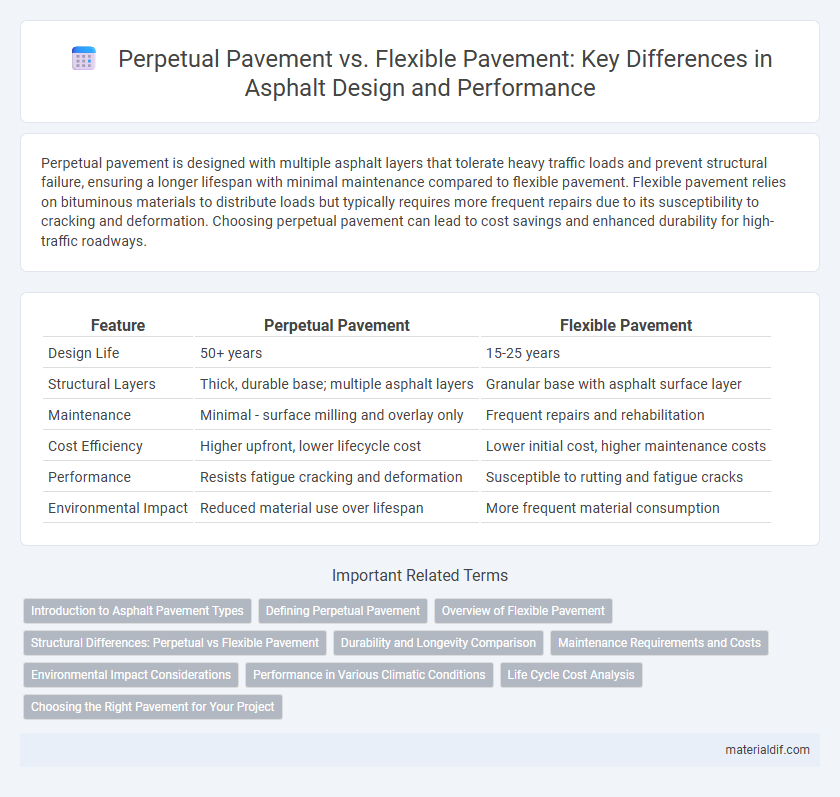Perpetual pavement is designed with multiple asphalt layers that tolerate heavy traffic loads and prevent structural failure, ensuring a longer lifespan with minimal maintenance compared to flexible pavement. Flexible pavement relies on bituminous materials to distribute loads but typically requires more frequent repairs due to its susceptibility to cracking and deformation. Choosing perpetual pavement can lead to cost savings and enhanced durability for high-traffic roadways.
Table of Comparison
| Feature | Perpetual Pavement | Flexible Pavement |
|---|---|---|
| Design Life | 50+ years | 15-25 years |
| Structural Layers | Thick, durable base; multiple asphalt layers | Granular base with asphalt surface layer |
| Maintenance | Minimal - surface milling and overlay only | Frequent repairs and rehabilitation |
| Cost Efficiency | Higher upfront, lower lifecycle cost | Lower initial cost, higher maintenance costs |
| Performance | Resists fatigue cracking and deformation | Susceptible to rutting and fatigue cracks |
| Environmental Impact | Reduced material use over lifespan | More frequent material consumption |
Introduction to Asphalt Pavement Types
Perpetual pavement is designed with multiple durable asphalt layers to resist structural failure and extend lifespan indefinitely, while flexible pavement relies on surface treatments and base layers that require periodic rehabilitation. The key distinction lies in the structural design: perpetual pavement employs thicker, fatigue-resistant asphalt courses to avoid cracking, whereas flexible pavement distributes loads through aggregate base and sub-base layers. Understanding these fundamental differences helps optimize pavement performance and maintenance strategies for varying traffic loads and environmental conditions.
Defining Perpetual Pavement
Perpetual pavement is a long-lasting asphalt pavement design characterized by multiple layers engineered to resist structural fatigue indefinitely, minimizing the need for major reconstruction. Unlike flexible pavement, which may require frequent rehabilitation due to structural failure, perpetual pavement uses a thick, durable asphalt base that provides continuous load distribution and surface renewal. This design emphasizes sustainability and life-cycle cost efficiency by extending pavement service life beyond traditional methods.
Overview of Flexible Pavement
Flexible pavement consists of multiple layered materials designed to distribute traffic loads over the subgrade, primarily using asphalt concrete for its surface course. This type of pavement offers adaptability to minor subgrade movements and temperature fluctuations, reducing cracking compared to rigid alternatives. Its maintenance involves periodic resurfacing to restore the surface layer, ensuring long-term performance and cost-effectiveness.
Structural Differences: Perpetual vs Flexible Pavement
Perpetual pavement features a multi-layered design with a strong, durable base that resists fatigue and requires only surface renewal, while flexible pavement relies on layers that flex under loads and need more frequent rehabilitation to address structural distress. The structural rigidity of perpetual pavement minimizes deformation and cracking, extending pavement life significantly compared to the repetitive maintenance cycles of flexible pavement. Advanced materials and engineering in perpetual pavement optimize load distribution, reducing subsurface damage typical in flexible pavement systems.
Durability and Longevity Comparison
Perpetual pavement offers superior durability with multiple layers designed to resist structural fatigue and surface wear, extending the pavement's lifespan beyond 40 years. Flexible pavement, while cost-effective upfront, typically requires major rehabilitation every 15 to 20 years due to rutting, cracking, and material degradation. The engineered design of perpetual pavement minimizes maintenance frequency and lifecycle costs by maintaining structural integrity under heavy traffic loads.
Maintenance Requirements and Costs
Perpetual pavement requires significantly lower maintenance costs due to its durable multi-layer design that minimizes structural fatigue and surface deterioration, reducing the need for frequent repairs compared to flexible pavement. Flexible pavement often incurs higher maintenance expenses because it is more susceptible to cracking, rutting, and moisture damage, necessitating regular overlays and patching. Long-term cost analysis shows perpetual pavements offer better lifecycle cost efficiency, despite higher initial construction investment.
Environmental Impact Considerations
Perpetual pavement significantly reduces environmental impact by minimizing the need for frequent reconstruction, thereby lowering material consumption and greenhouse gas emissions over its lifespan. Flexible pavement often requires more frequent maintenance and replacement, leading to higher resource depletion and increased carbon footprint. Sustainable infrastructure strategies favor perpetual pavement for its durability and reduced life cycle environmental costs.
Performance in Various Climatic Conditions
Perpetual pavement exhibits superior performance in diverse climatic conditions due to its multi-layer design that resists cracking and rutting over time, ensuring durability under extreme temperatures and fluctuating moisture levels. Flexible pavement adapts well to thermal expansion and contraction but is more susceptible to deformations like potholes and fatigue cracking in freeze-thaw cycles and heavy rainfall. Long-term studies show perpetual pavement maintains structural integrity with minimal maintenance, making it ideal for regions with varying weather patterns.
Life Cycle Cost Analysis
Perpetual pavement offers superior life cycle cost efficiency compared to flexible pavement due to its design aimed at minimizing structural fatigue and requiring only surface layer rehabilitation. Flexible pavement typically incurs higher maintenance costs over time, including frequent repairs and resurfacing, which increase total life cycle expenses. Life Cycle Cost Analysis (LCCA) demonstrates that despite higher initial construction costs, perpetual pavements achieve lower overall costs through extended service life and reduced maintenance frequency.
Choosing the Right Pavement for Your Project
Perpetual pavement offers long-term durability with a strong structural design that resists fatigue cracking, making it ideal for high-traffic roadways requiring low maintenance. Flexible pavement, composed of layered asphalt, provides versatility and cost-effective initial construction for varying load conditions and quicker project timelines. Selecting the right pavement depends on traffic volume, budget constraints, and desired lifecycle performance to optimize both longevity and maintenance costs.
Perpetual Pavement vs Flexible Pavement Infographic

 materialdif.com
materialdif.com